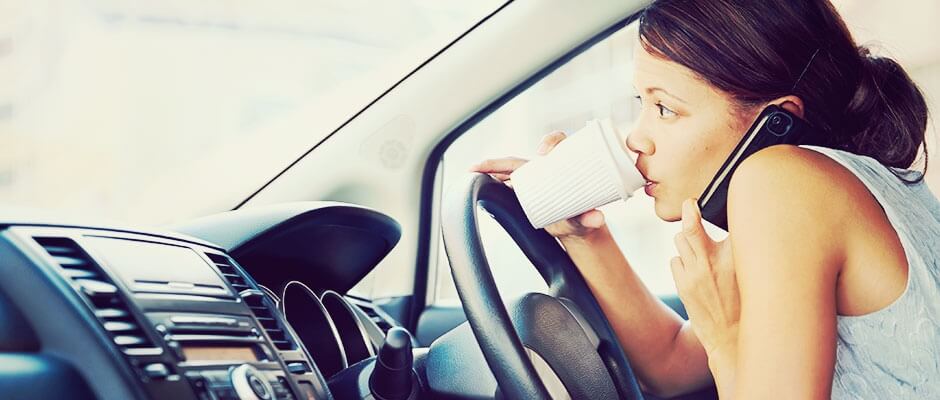Distracted driving is a significant cause of car accidents, as well as a popular topic of discussion in today’s technology-obsessed world.¹ Recent documentary programmes such as Panorama have explored the issue of distracted driving, while the rise in gadget use gives drivers more sources of distraction. For example, the development of in-car ‘infotainment’ systems may cause further distraction for drivers in the future; this is a growing concern for many road safety professionals.²
Here’s our guide to driver distractions, with advice to help you stay safe on the road.
Passengers
Recent studies suggest that the biggest distraction for drivers is passengers in the car.³ This is because passengers can interrupt a driver’s concentration with loud conversations or comments.
Parents driving with children in the back seat can be encouraged to engage in distracting behaviour, such as turning round to assist them.⁴ Furthermore, some young drivers may feel pressured to ‘show off’ in front of friends by speeding.⁵
Check out this short film from Drive Smart Surrey about the dangers of peer pressure:
What’s the risk?
Fact: With two or more passengers, the risk of a serious accident for 16-19 year-old drivers is more than five times the risk when driving alone.⁶
Using a mobile phone
It’s common to be tempted to check your phone while driving, but the split second of looking away from the road could have serious consequences.
What’s the risk?
Using a mobile phone behind the wheel halves reaction times⁷, as well as making it difficult to control speed and lane position.
Fact: a driver is four times more likely to crash if they use a mobile phone while driving.⁸
Did you know?
It’s illegal to use a hand-held mobile when driving on the road even if you’ve stopped at traffic lights, you are stuck in a traffic jam or you are in a car park.⁹
Check out this clever ‘Eyes on the road’ advert by Volkswagen:
Find out more about the dangers of texting while driving.
Using a sat nav
Sat navs can be extremely beneficial for drivers, providing routes that can save time and money on fuel. However, staring at the screen and taking your hand off the wheel to adjust the settings diverts attention from the road.
What’s the risk?
Recent research by the Institute of Advanced Motoring (IAM) found that nearly one in ten drivers were involved in an accident due to distracted driving – with 15% of these identifying sat navs as the distraction.¹⁰
Eating and drinking
Although it is not an offence to eat or drink while driving, it is included in the list of driving distractions in the Highway Code.¹¹ If any of these distractions result in driving ‘without due care and attention’, you could still receive the appropriate punishment from the police.¹²
What’s the risk?
Eating and drinking usually causes the driver to remove at least one hand from the vehicle, as well as slowing down their reaction times. Research has found that drivers who eat and drink at the wheel are twice as likely to crash.¹³

Tips for avoiding distractions
- Before you set off, make sure you allow plenty of travel time and review your route if you aren’t familiar with it.
- If you feel that other passengers are distracting you, don’t be afraid to tell them to keep their voices down or even stop talking completely, especially if you’re approaching a hazard.
- If you need to adjust the settings on your sat nav, pull over first. Receiving spoken instructions as well as visual instructions will help stop you looking away from the road too frequently.
- Keep your mobile phone out of sight so you’re not tempted to look at it if you receive a call or text.
- Avoid eating and drinking while driving – find a safe place to pull over if you’re feeling peckish.
- Keeping your vehicle tidy and securing loose items will prevent them from distracting you.
- If you want to do anything else that may distract your driving, make sure you pull over in a safe place first.
Sources:
[1] http://www.brake.org.uk/info-resources/info-research/road-safety-factsheets/15-facts-a-resources/facts/1131-distractionfacts[2] http://www.huffingtonpost.com/2013/08/08/infotainment-distracted-driving_n_3721793.html
[3] http://www.fleetnews.co.uk/news/2014/7/22/adult-passengers-are-the-biggest-in-car-distraction-for-drivers/53064/
[4] http://www.telegraph.co.uk/motoring/10479254/Children-in-cars-more-distracting-than-mobiles.html
[5] http://www.insurethebox.com/young-drivers-insurance/first-time-car-insurance-and-carrying-same-age-passengers
[6] http://www.brake.org.uk/info-resources/info-research/road-safety-factsheets/15-facts-a-resources/facts/488-young-drivers-the-hard-facts
[7] [8] http://think.direct.gov.uk/mobile-phones.html
[9] [11] https://www.gov.uk/general-rules-all-drivers-riders-103-to-158/general-advice-144-to-158
[10] http://www.iam.org.uk/component/content/article?id=20442
[12] http://www.theaa.com/motoring_advice/legal-advice/careless-driving.html
[13] http://www.brakepro.org/assets/docs/practitioner-tools/fleet-guidance-13-distractions.pdf
